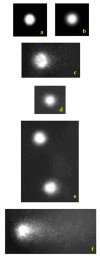Assessing the Potential Synergistic/Antagonistic Effects of Citrinin and Cannabidiol on SH-SY5Y, HepG2, HEK293 Cell Lines, and Human Lymphocytes
- PMID: 39728792
- PMCID: PMC11679033
- DOI: 10.3390/toxins16120534
Assessing the Potential Synergistic/Antagonistic Effects of Citrinin and Cannabidiol on SH-SY5Y, HepG2, HEK293 Cell Lines, and Human Lymphocytes
Abstract
The increasing use of Cannabis sativa products for medicinal, dietary, and recreational purposes has raised concerns about mycotoxin contamination in cannabis and hemp. Mycotoxins persist in these products' post-processing, posing health risks via multiple exposure routes. This study investigated cytotoxic and genotoxic interactions between cannabidiol (CBD) and the mycotoxin citrinin (CIT) using human cell models: SH-SY5Y, HepG2, HEK293, and peripheral blood lymphocytes. IC50 values and membrane disruption were initially assessed, followed by an evaluation of genotoxicity in lymphocytes using the Comet Assay and Cytokinesis Blocked Micronucleus Cytome Assay. Obtained findings demonstrate that cell-type sensitivity varied across treatments, with combined CBD and CIT exposure exhibiting distinct interactions. Lactate dehydrogenase (LDH) release remained minimal, suggesting cytotoxicity did not stem from membrane disruption but likely involved intracellular pathways. In lymphocytes, CBD alone produced negligible cyto/genotoxic effects and weak antiproliferative responses, whereas CIT displayed clear toxic impacts. DNA damage indicates that CIT may induce genome instability through indirect mechanisms rather than direct DNA interaction, with evidence of potential aneuploidic effects from the CBMN Cyt Assay. Combined exposure led to a reduction in CIT-induced DNA and cytogenetic damage, suggesting CIT's potential interference with the beneficial properties of CBD. These results provide a foundation for further toxicological assessments and highlight the necessity of standardized mycotoxin monitoring in cannabis-derived products.
Keywords: Cannabis sativa; cell viability; contaminants; cytotoxicity; genotoxicity; hemp; moulds; mycotoxins.
Conflict of interest statement
The authors declare no conflicts of interest.
Figures







Similar articles
-
Exploring the safety of cannabidiol (CBD): A comprehensive in vitro evaluation of the genotoxic and mutagenic potential of a CBD isolate and extract from Cannabis sativa L.Biomed Pharmacother. 2024 Aug;177:116969. doi: 10.1016/j.biopha.2024.116969. Epub 2024 Jun 21. Biomed Pharmacother. 2024. PMID: 38908200
-
Protective Action of Cannabidiol on Tiamulin Toxicity in Humans-In Vitro Study.Int J Mol Sci. 2024 Dec 18;25(24):13542. doi: 10.3390/ijms252413542. Int J Mol Sci. 2024. PMID: 39769305 Free PMC article.
-
Cytotoxic, genotoxic and biochemical markers of insecticide toxicity evaluated in human peripheral blood lymphocytes and an HepG2 cell line.Food Chem Toxicol. 2016 Oct;96:90-106. doi: 10.1016/j.fct.2016.07.036. Epub 2016 Jul 30. Food Chem Toxicol. 2016. PMID: 27481072
-
Cytotoxic Profiles of Beauvericin, Citrinin, Moniliformin, and Patulin and Their Binary Combinations: A Literature-Based Comparison and Experimental Validation in SH-SY5Y Cells.Toxins (Basel). 2025 Mar 17;17(3):143. doi: 10.3390/toxins17030143. Toxins (Basel). 2025. PMID: 40137916 Free PMC article. Review.
-
Does the recommended lymphocyte cytokinesis-block micronucleus assay for human biomonitoring actually detect DNA damage induced by occupational and environmental exposure to genotoxic chemicals?Mutagenesis. 2013 Jul;28(4):375-80. doi: 10.1093/mutage/get026. Epub 2013 May 3. Mutagenesis. 2013. PMID: 23644166 Review.
Cited by
-
Citrinin-Induced Cellular Damage: Insights from SH-SY5Y Cell Line Studies.Foods. 2025 Jan 22;14(3):356. doi: 10.3390/foods14030356. Foods. 2025. PMID: 39941949 Free PMC article.
References
-
- International Agency for Research of Cancer (IARC) IARC Monographs on the Evaluation of the Carcinogenic Risk of Chemicals to Humans. Volume 40 IARC P; Lyon, France: 1986.
Publication types
MeSH terms
Substances
LinkOut - more resources
Full Text Sources

